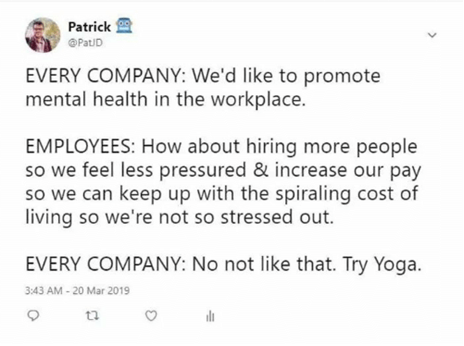Valued at over $4 trillion in 2018, the wellness industry has brought a monetary and mainstream focus to health, fitness, nutrition, and overall well-being. The industry has recently been critiqued for straying away from actual health in favor of trends, like adding yoga and meditation to everyone’s repertoire even if those practices might not be the right fit for all individuals.

While plenty of folks have turned to alternative medicine and “holistic” practitioners when western medicine lacked answers, or more likely affordability, many people still lack the very baseline of health: financial stability, access to affordable healthcare, and work life balance. I spoke with Sarah-Valin Bloom, Licensed Clinical Social Worker, last month to discuss the ways companies can create better environments and support structure for their employees and contractors beyond throwing in a yoga class here and there.
When I brought up the above meme, she added “meditation is awesome but it’s a program,” as opposed to an actual tenant of wellness.
The TL;DR when it comes to incorporating wellness in the workplace lies with a few core practices:
- fair financial compensation
- comprehensive benefits
- cultivating a “culture of wellness” — explained in more detail belo
Benefits provide the infrastructure to support the culture. Financial stability cultivates the peace of mind. That gives you a solid foundation for wellness before you even step onto a yoga mat. She also emphasized that diversity, equity, and inclusion are an integral part of wellness, asking, “how is there psychological safety in a place where you don’t belong?” And the best way to implement these practices according to Valin-Bloom? “You have to lead by example.”
To dive deeper, here’s an edited (for length) transcript of our conversation. All emphases mine.
ALESSANDRA CALDERIN: In your experience, what is, first and foremost, the most important thing for a company to implement in order to be able to say they care about wellness? (In contrast to “just do yoga,” for example.)
SARAH-VALIN BLOOM: I think first and foremost, it’s important to recognize that wellness programming isn’t yoga. Things like yoga and meditation are great, but that’s not wellness. Wellness is something that is all encompassing. [It’s really important] to create a culture of wellness, but you can’t have that if you don’t have the basic, fundamental building blocks to build that culture upon.
Benefits are the number one thing, in my mind. You want to make sure that if you are saying, “we care about your well-being,” that you are offering the people you employ benefits that cover healthcare, that cover mental healthcare, that support things like childcare, and other necessities. Benefits don’t have to end at medical and dental coverage.
There are a lot of things that you can put in place to support employees. EAPs are a great example of it. Employee Assistance Programs can offer access to free therapy services, for example. Usually, a company will contract to provide a certain number of sessions, but EAPs can also do so much more. There are EAPs that can help your employees connect with somebody to provide childcare, or a handyperson to come in and fix things, or somebody to help clean their house. These services make the stresses and burdens that everybody has to deal with at various levels, easier.
AC: Let’s say a company wants to do that, but they have budgetary restrictions. What is the hierarchy of what must come first?
SVB: Obviously, there are benefits that companies are more obligated to provide like health insurance coverage. If budgetary restrictions are a barrier to additional benefits, employers should consider developing programs internally to support, bolster, and supplement the benefits they do offer. It’s complicated. Obviously, finances for a business are always what things come down to. Unfortunately, the bottom line is the bottom line, and if you can’t afford to do certain things, it can be limiting. But if you’re going to think about the way you’re allocating funds, and you really do want to encourage wellness, you have to thoughtfully invest in resources for your employees and get creative when developing programming internally.
AC: And if you’re explaining to a company why this is beneficial to their bottom line, how do you do that?
SVB: There are two issues. There are people, and then there are functions. The bottom line at the end of the day: Businesses need to meet the expectations of their customers. If they’ve promised customers a specific ROI, they want to know they are delivering on that ROI. They want to see productivity. That return is the result or the function; the work being done. But the reality is that those functions are being completed by humans. By people. And if people are not taken care of, if people are unwell in some way, be it mental or physical, it’s going to impact their ability to perform in their role and deliver what is being asked of them.
It is the reality for all of us, as human beings. If we are not okay, or if we are functioning at less than 100%, then the output is not going to be what it would be otherwise. We are less able to take care of other people. We are less able to take care of ourselves. It’s something that we all have to learn at some point. As a therapist, I think it’s learned more explicitly — you must learn how to take care of yourself if you are expected to hold space and help others.
But the same rules apply in any job. If you are not well, then you’re just not going to do the same kind of work, and it’s not going to be sustainable. Pushing through without addressing your mental health leads to burnout or compassion fatigue (if you’re working in a helping profession). People need to be taken care of. Part of that is the responsibility of the individual — to know when they need something or what they might need. But there’s also a big responsibility on the employer, not only to offer benefits, but to encourage employees to use them. For example, there are many companies who offer unlimited paid time off, which is incredible. What a wonderful benefit to offer your employees. But not everybody knows when to take time off, and they will work themselves into the ground until they hit a wall.
So, when companies offer benefits like unlimited paid time off, having leaders and managers who encourage employees to take advantage of it is invaluable and key to preventing things like burnout. This ensures that people are taking adequate time off regularly, whether it be mental health days when needed or a week off in a particular quarter. There should be a minimum of expectation for time off, and those things should be made very explicit by managers. Oftentimes companies that offer unlimited paid time off also have very high performing, very driven employees, and they’re much less likely to take advantage of that.
AC: It seems like the culture at a lot of companies that offer unlimited PTO is that no one take it. It’s like a competition.
SVB: I think competition can be part of it, but I think it’s more about the culture that we live in. In the US, there’s this concept where you put your head down, you get your work done, and you work, work, work. Whereas if you live in other parts of the world, people are not living to work, they are working to live.
I was recently talking to a colleague of mine who was saying that he worked at the same company in two different countries. The benefits were the same, but the way you were encouraged, or sometimes discouraged, to use those benefits was felt deeply. It made it feel like a different company even though everything was technically the same.
This highlights something I talk about all the time, which is a “culture of wellness.” Although our work culture is not necessarily oriented in that way, as an employer, you have an opportunity and responsibility to cultivate a culture of wellness. It’s the responsibility of leadership, management, and the responsibility of everybody to uphold that. If you’re going to offer benefits and programming and espouse certain things, you must stand behind them and encourage utilization.
AC: Which countries were the best?
SVB: Specifically, we were talking about the UK and Europe. The idea of working part-time or a four-day work week, is not unheard of. Taking an entire month off may even be acceptable. We are just not oriented in that way. That’s not the way we built “work” in the US.
I believe now, more than ever, there’s this opportunity in that world to make changes. COVID has forced us to reimagine and reevaluate how we do things. Even larger companies are starting to reevaluate things COVID has completely changed the game and the conversation.
AC: So even with things like benefits and paid time off, we have these devices [gestures to smart phone] that are attached to us 24/7. Our employers have constant access to us, and a lot of the time people feel pressure to respond to everything that comes in — and respond immediately. What have you been working on with people to figure out how to set boundaries and manage expectations?
SVB: I think you said it perfectly. Setting boundaries is so important. And that can look very different for different people. When people started to work from home full-time because of the pandemic, there was this feeling of working 24/7. On and connected all the time because you never technically left the office; the office was now at home.
AC: What are some solutions to that?
SVB: Become aware and begin to make an effort and take the steps to set the boundaries that you need. The things that work for you. For example, set a time of day to turn your computer off.
If you have a separate workspace, use that exclusively as your workspace and then leave it at the end of the day.
For other people who don’t have the luxury of a separate workspace, turn your computer off, turn off notifications on your phone at a certain time so that you are really not available.
Let your team know if there is something urgent that they need, obviously they can text message you or call you, but outside of that, you won’t be checking emails or taking meetings after a certain time.
Blocking off time throughout the workday for self-care is also incredibly important. Part of that is understanding what self-care looks like for an individual. What self-care is for them, how that fits into their day, committing to it, and then scheduling it.
So, in the same way you turn your computer off at a certain time, you also have a time block set to go outside for a walk or run. To do something that is replenishing. And to really honor that as protected time.
Going back to the culture piece, you have to live and lead by example. All of these changes come from leadership. For example, if your manager is blocking time on their calendar for self-care, and they call it out as that, they are setting an example. Whether that’s therapy, going for a run, stretching, taking their dog for a long walk, whatever that looks like for them. If it’s public knowledge, it makes it okay for the people who report to them to do the same. It sets a tone, it sets an example, and it opens the conversation without even having to have the conversation.
So, when that manager sees somebody struggling or sees somebody having a tough time, it makes the conversation easier. Asking someone about how they are taking care of themselves is not asking anyone to do something you yourself have not committed to.
You can say:
Hey, how are you doing?
Are you taking care of yourself?
Are you taking time out for yourself throughout the day?
I want to make sure that you’re doing those things.
I block time on my calendar, I want to make sure you feel comfortable blocking time on your calendar if that’s what works.
Obviously, everybody’s work circumstance is different. For example, some people work on a shift and don’t have the luxury of blocking out time, but there are other things that may be able to be implemented around that.
AC: What about when it comes to freelancers and those in the gig economy? Have you worked with anyone who works under those circumstances? What are solutions to that? What are things employers can offer them?
SVB: When employers are thinking about benefits for employees, coming up with things that are accessible to contracted employees is really important.
For example, programs that are developed internally can often be easily offered to or accessed by contracted employees. Depending on the nature of the contract, the work, and the expectations, contracted employees may also be able to block some time out. Setting reasonable deadlines as a project manager is important. Don’t be your own worst enemy in scheduling your time, you have control over it.
Again, I think it ties back to the way we approach work culturally. The idea that “I have 8 hours in my day but I’m going to get 16 hours of work done” is something that is far too common. That’s not sustainable for anybody. It’s like running a machine 24/7 with no break. Eventually that machine is just going to break down. And we are not machines. But I think it’s a fair metaphor. Because nothing, even a machine, can operate sustainably for extended periods of time without care.
About the author.
Alessandra is the mentor, educator, and writer behind Boneseed, a private practice devoted to deep self-inquiry through a range of physical, energetic, and mental modalities. She has over 500 hours of yoga, mentorship, and facilitation training and can be found slinging knowledge on her website, newsletter, and @bone.seed.




